If your dog is showing any symptoms of eating something toxic such as vomiting, drooling, diarrhoea, excessive panting, trembling or an increased heart rate, be sure to contact your vet immediately.
Something all dog owners should know is that chocolate is NOT on the menu for our pooch.
But with chocolate dominating many of our annual celebrations, there’s usually a lot lying around the house - especially at Christmas and Easter. So, what should you do if your dog manages to eat your chocolate on the sly?
In this article, we’ll tell you why chocolate is toxic to dogs, how to prevent your pooch from getting into anything chocolatey, and what to do, step-by-step, if your dog munches on your chocolate treats.
Can dogs eat chocolate?
Dogs can’t eat any chocolate made for humans under any circumstances because it contains ingredients that the delicate canine body can’t process. Put simply, when dogs eat chocolate, it can have toxic or even lethal side effects.
Can my dog eat white chocolate?
White chocolate is less harmful to a dog than milk chocolate and dark chocolate, which is the most toxic. However, it’s still packed full of sugar, fat and often artificial ingredients which are of no nutritional benefit to them. Best to steer your pooch away from all chocolate, unless it’s the kind that is made specifically for dogs.
Can my dog eat dark chocolate?
No - a dog should not eat dark chocolate under any circumstances.
Dark chocolate contains a higher percentage of cocoa solids and therefore has a more condensed amount of theobromine, the toxic compound that affects a dog’s nervous system and can prove fatal.
Vet Linda also warns:
"Dog owners should also be mindful that, as well as regular chocolate, cocoa powder and baking chocolate are very toxic, much like dark chocolate. Plus, many toppings and added ingredients in chocolate can also be extremely toxic and should be taken into consideration, especially common additions like nuts and raisins."

What makes chocolate poisonous for dogs?
The main ingredient in chocolate that is toxic to dogs is theobromine.
This is a compound that the human body can digest just fine, but dogs can’t metabolise in the same way. Chocolate also contains caffeine, which can be similarly dangerous to pooches.
Both of these substances impact the canine nervous system and kidneys, essentially speeding up their heart rate to unmanageable levels and leading to serious health issues or, in the most severe cases, death.
Symptoms of chocolate poisoning in dogs
Here are the main symptoms that may show if your pooch has eaten chocolate, from least to most severe.
-
Increased drinking and peeing. Theobromine acts as a diuretic, so your dog will be thirsty and want to pee more.
-
Restlessness or trembling. Your dog may become jittery, unable to settle, or overly hyperactive in a way that seems unusual for them.
-
Vomiting and diarrhoea. Your dog’s body will try to get rid of the toxins from the chocolate, often leading to an upset stomach.
-
Increased heart rate and excessive panting. Theobromine stimulates the heart, causing irregular or rapid heartbeats, so your pooch will breathe quicker.
-
Muscle tremors or seizures. Severe chocolate poisoning affects the nervous system, causing shaking or even full-blown seizures.
-
Coma or death. In extreme cases, chocolate poisoning can cause your dog to fall into a coma, and at worst, it can be fatal.

What to do if your dog eats chocolate
If you know or suspect that your dog has eaten chocolate, firstly, be calm. It’s understandable (and sensible!) to be concerned, but it’s really important that you’re able to think clearly and take the following steps.
-
Check and monitor for symptoms. Is your dog vomiting or breathing rapidly? Are they hyperactive or behaving out of sorts? See below for a full list of symptoms - and be aware that symptoms might not appear until 6-12 hours after eating chocolate.
-
If possible, find out what they’ve eaten and how much of it. The type and amount of chocolate your dog has eaten is essential information for your vet.
If you’ve got any chocolate wrappers of what they’ve eaten, keep them handy so you can refer to the list of ingredients.
-
Call a vet immediately. The vet should then offer you advice on what to do next based on your dog’s breed, age, weight and any current health issues, and may suggest you bring them into the surgery.
-
Do not induce vomiting unless your vet recommends it. This can cause more harm unless your vet thinks it’s necessary.
-
If your dog shows no symptoms, keep a close eye on them. If you think your pooch ate only a small amount of chocolate and they seem fine, observe them closely in the following 24 hours.
-
Symptoms can show up within 6-12 hours after eating and the sooner they get treatment, the better.
How long after eating chocolate will a dog get symptoms of poisoning?
What do you do if your dog has eaten chocolate but is acting fine?
Though this can happen, your pooch isn’t safe yet - symptoms of chocolate poisoning sometimes don’t show until 6-12 hours after eating it. This is why it’s super important to watch your dog if you think they’ve eaten chocolate and take note of how they’re behaving.
If they’ve eaten a large amount of chocolate, call a vet immediately, whether they are showing symptoms or not. Fast treatment of chocolate poisoning can make the difference between life and death.
How much chocolate is dangerous for a dog?
Even small amounts of theobromine in chocolate can be dangerous to your dog’s nervous system, but how much impact it has is usually determined by the size of your dog in relation to how much chocolate they’ve eaten.
It also depends on the type of chocolate (dark chocolate is most dangerous as it contains the most cocoa solids, which is where theobromine is naturally found).
As the risks are dependent on the ‘amount of chocolate-to-body weight’ ratio, the danger of chocolate poisoning is bigger if your dog is small.
However, even a large dog can have a severe reaction to chocolate if they eats too much. If a large dog has eaten a tiny piece of chocolate, they may not experience any harm - but you should be extremely vigilant to check for symptoms either way.
Can dogs die from eating chocolate?
Yes, if a dog eats too much chocolate, it can be lethal.
It’s extremely important to keep chocolate out of a dog’s reach, and if they do manage to eat some, are showing symptoms, or they’ve eaten a large amount, seek treatment immediately to avoid the worst-case scenario.
Preventing your dog from eating chocolate
There are so many events in life we celebrate with chocolate, and this can pose a big risk. Keeping your pooch far away from chocolate should be a top priority in your home.
-
Keep all chocolate out of reach. Chocolate should never be left around the house, on the couch or in low cupboards - keep it high up and in a box or behind a secure cupboard door.
When you're finished snacking, be sure to wrap up any leftovers and tidy them away. Also, be extra wary of handbags or shopping bags on the floor that are easily nosed into
-
Teach your pooch the ‘Leave it’ command. A well-trained dog is a safer dog. Be sure your pooch knows the command ‘leave it’ and reward them with praise when they obey.
-
Give them their own dog-friendly treats. Keep some tasty dog treats on hand to distract your dog while you or others in the house are eating chocolate.
-
Be extra careful around holidays. Easter time is prime chocolate season, as well as Christmas and birthdays. With so much chocolate lying around, it’s extra important to keep the chocolate and the dog far away from each other.

-
Keep children in the know. If you have children at home, make sure they know what they can and can’t feed the dog - and warn any children visiting the house, too.
What other foods are toxic to dogs?
As well as chocolate, make sure you’re aware of other common foods that are toxic to dogs. Onions, garlic and grapes are common food items you'd find in any kitchen, and are also extremely toxic to dogs. To explore more about other non-dog friendly foods, be sure to read our article exploring the dangers of feeding your dog some human foods.
What can I give my dog as a treat instead of chocolate?
If you don’t want your dog to miss out on a sweet treat, you could feed some of these sweet dog treats instead:
-
Peanut butter dog treats are irresistible to dogs and can distract them from nasty chocolate. Our peanut butter dog treats are also packed with gut-friendly probiotics.
-
Blueberries offer a burst of sweetness along with vitamins and antioxidants.
-
Banana (in moderation) is a soft and tasty snack for a pooch that is full of health benefits.
FAQs
Can I give my dog a small piece of chocolate?
No, you should never feed your dog chocolate. It’s toxic to dogs, and even a small piece can cause harm, especially in smaller dogs. If a large dog has eaten a small piece of chocolate without you knowing, they may get away with it and not be harmed, but that doesn’t mean you should intentionally give chocolate to your dog under any circumstances.
What is ‘dog-friendly’ chocolate?
You may have seen ‘dog-friendly’ chocolate in pet stores and online. This is safe for dogs because it’s made with carob, a cocoa alternative that tastes chocolatey but doesn’t carry the same risks to dogs as cocoa. Though it’s safer for dogs, it’s still considered a treat, so don’t feed your pooch dog-friendly chocolate as a food replacement.
If you’re looking for dog-friendly chocolate-alternatives for your pooch over the Easter period, Pooch & Mutt healthy treats for dogs are bursting with organic ingredients and gut-friendly probiotics, in flavours like peanut butter, shrimp and turkey & hemp.






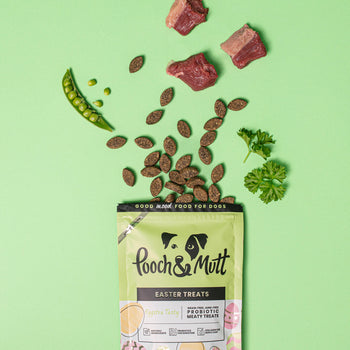
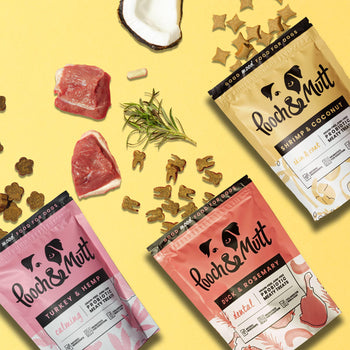
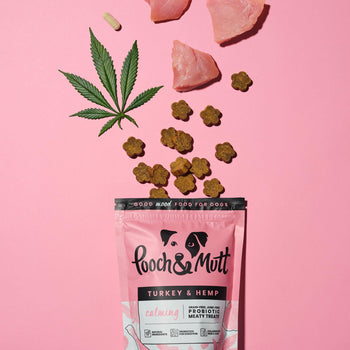
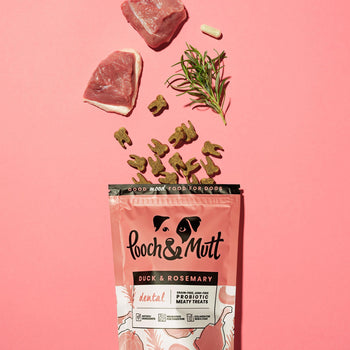
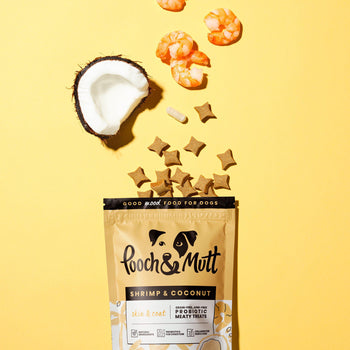







Comments (0)
Leave a comment